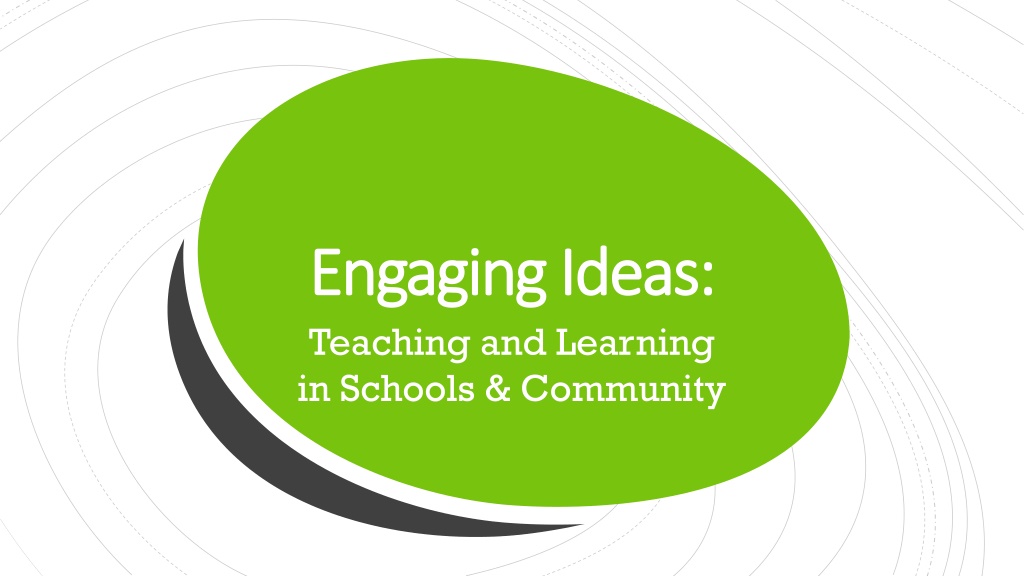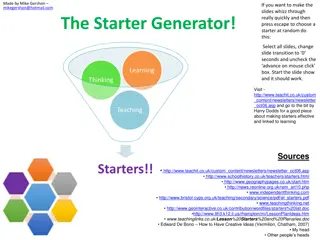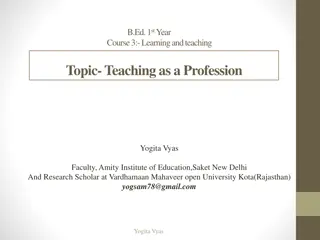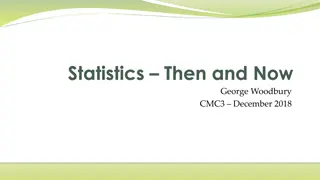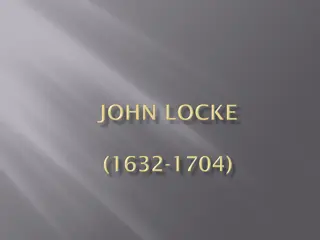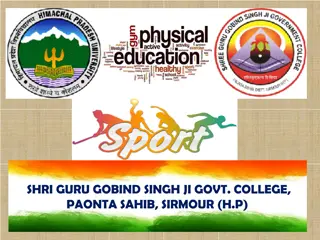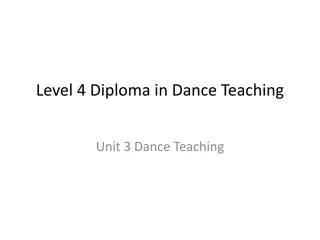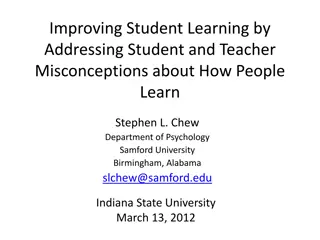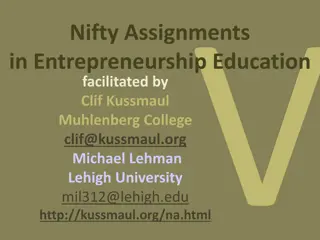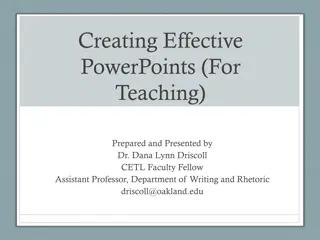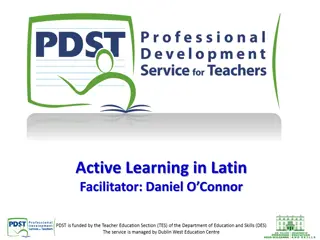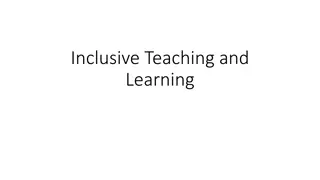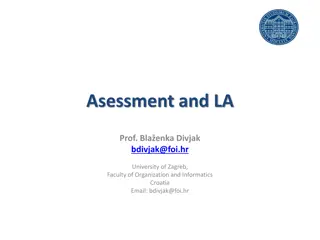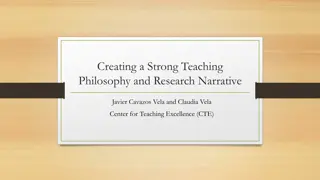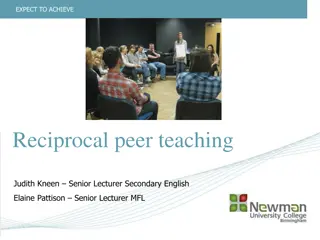Exploring Engaging Ideas in Teaching and Learning
Dive into a stimulating discussion on teaching and learning in schools and communities, highlighting current trends, research, and strategies. Join an experienced instructor and PhD student from Queen's University as they share insights on engaging learners, sharing anecdotes, and fostering impactful educational practices.
Download Presentation

Please find below an Image/Link to download the presentation.
The content on the website is provided AS IS for your information and personal use only. It may not be sold, licensed, or shared on other websites without obtaining consent from the author. Download presentation by click this link. If you encounter any issues during the download, it is possible that the publisher has removed the file from their server.
E N D
Presentation Transcript
Engaging Ideas: Engaging Ideas: Teaching and Learning in Schools & Community
Big thanks for inviting me (back) to talk ! Big thanks to organizers. Big thanks for what you do! First of all First of all
What we will explore today What we will explore today Highlight good things happening in your practice Research on Learning Making information accessible for schools and community Current trends in teaching & learning
Instructor at Queens University in Kingston, ON, training pre-service teachers in the Bachelor of Education program PhD student at Queen s University Ontario Certified teacher with experience teaching children (K-12) and adults High school teacher abroad for several years at the worst school in the UK Social emotional learning and arts based, experiential learning strategies Community outreach with adults with intellectual disabilities, at-risk youth, older adults My work My work
What does it mean to engage What does it mean to engage your learners? your learners? With your table group, please write a list of ideas, words, images that come to mind.
Actual reactions when I agreed to do the presentation last year: 1) If I was going to get to slide down the pole? 2) Movie references. The gasoline fight/fire in the movie Zoolander, Leslie Nielson, Mr. Bean. 3) Various calendar jokes. 4) Oh wow, that s great that they are doing that! Are we Are we surprised? surprised?
Memories of my dad testing my smoke alarms. Leaving a hair straightener ON under my bed for a month, plugged in without realizing. Stories in the news forest fires, apartment building fires, etc. My own My own associations/ associations/ bias bias My dad always saying: Blow out your candles the times I forgot and left the house. As a teenager, my friend s house burning down Images of fire in myth, arts & culture, etc. An ex-partner s sister with MS passed away in a house fire
We must plan ahead to: Care for self Care for others (community) Care for the classroom/ space/environment Good teaching Good teaching involves a great deal involves a great deal of risk assessment, of risk assessment, planning, and care. planning, and care.
What could What could possibly go possibly go wrong? wrong?
Mr. Bean gets Mr. Bean gets educated. educated.
How do we How do we learn? learn?
KIDS Where do you think kids get most of their impressions about fire & life safety? Our beliefs and Our beliefs and prior learning prior learning matter. matter. ADULTS Where do you think adults get most of their impressions about fire & life safety?
Please recall a memorable learning experience from your past. It could be learning how to ride a bike as a child, or cook a particular meal or a work-related workshop you took but choose one that stands out for you, personally. Take a brief Take a brief moment moment Please identify the circumstance and in 1-2 sentences please try to explain why it was memorable. What made it so?
That we are most motivated to learn when our needs are met and we feel: 1. autonomous/independent 2. competent 3. a sense of belonging/relatedness The research The research suggests suggests
That we learn when are able to make connections to our own lives/experiences When we feel it is of importance/value When it is enjoyable, when we think we can. When we want to grow. By teaching others And also And also
What practices have you seen/used in fire safety education (in schools or community) that support any of these? Best practices Best practices
If you are not genuinely moved, invested, curious, excited by what you are delivering if it doesn t give you goosebumps, make you excited, make you feel something, if you don t clearly understand it or engage with it, etc. your audience will very likely not be interested either. How could you motivate yourself, re-design your lesson or collaborate differently to make it more authentic? It s about a It s about a feeling. For you feeling. For you too! too!
The topics you are dealing with can also be sensitive; in your role as an educator you have to be aware of the potential impact of your content and method of delivery - and feelings of your target audience (and have appropriate strategies and support in place). And that means And that means we need to take we need to take extra care of extra care of ourselves and ourselves and each other. each other. This could be due to a trigger , past experience (e.g., consider the experience of a Syrian refugee student), a news item, or even a tricky day . Leave your problems at the door is a myth for most of us.
1)How/why did you personally come have a career in fire and life safety? 2)What has kept you in it/motivated? 3)What is the biggest misconception or misunderstanding you feel people have about fire, safety and/or this industry? Questions to Questions to consider. consider.
Engagement is essential, and is the key to most classroom management (e.g. often linked to listening, behaviour, etc.) Making connections with learning in other subject areas, prior knowledge, when possible. Props/tools/equipment/artifacts/photos Games, e.g. mystery, physicality, role play, obstacles, Escape Room style puzzles Some of the things Some of the things we see working in we see working in classrooms/ classrooms/ outreach outreach Competition Stories: personal, historical or about people the audience can relate to (their own age, celebrities, etc.) Humour (film, cartoon/comic, etc.) Different social dynamics: groups, individual, pair work (think/pair/share and Jigsaw), speed dating style,talking circles, non-teacher centred (i.e. give students the floor ) Choices
Incorporating technology/apps Element of surprise, using the senses, building anticipation by setting the scene, etc. Community/cross-curricular partnerships Innovative locations, experiential learning Extension activities and future challenges, leaving participants with great questions to think about Cont d Cont d Prizes/giveaways Food for community building! (when appropriate) Adults often report that their most memorable learning experiences involve the arts, body or nature Empowering someone with a role/title that indicates responsibility: You are a Fire Safety Expert. It s about building relationships and rapport
1) There is a natural awe, wonder and fascination with fire (even a possible negative interest could turn into a positive one in a teachable moment). The The Good Good News! News! 2) There are many fantastic, good quality tools and lesson plans out there to assist your work already! 3) There is a large degree of respect in our society for people who work in these industries. Typically you will be presenting to a supportive and interested audience.
Directions in Directions in Teaching & Teaching & Learning Learning
Gender/preferred pronouns it is becoming more common for students or teachers to identify their pronouns upfront Political climate and recent changes to curriculum Check out the work and wisdom of Dr. Lee Airton on respectful handling of issues related to gender/sexual diversity in the classroom https://educ.queensu.ca/lee-airton Using more inclusive terminology in classrooms and community settings, i.e. rather than boys and girls or ladies and gentlemen, try Grade 5s , using first names, saying Welcome, everyone! 1) Inclusive 1) Inclusive Language Language Sensitivities to family life, i.e. moms and dads , what is a family , heteronormative assumptions, etc. Land acknowledgement, respectful of Indigenous histories Respectful terminology around disability, accessibility, etc.
Ableism:discrimination (in belief or practice) based on a person s abilities, whether developmental, learning, physical, psychiatric or sensory. Ableism is a form of discrimination that devalues and disregards people with disabilities. Access/Accessibility:is the creation of an environment where people, regardless of their abilities, can communicate clearly and participate actively. A+ in accessibility A+ in accessibility (above definitions taken from http://www.chs.ca/glossary- terms) AODA training https://accessontario.com/aoda/
Staff Room Lingo Staff Room Lingo Every industry (Education and Fire & Life Safety included!) has its own language/terminology that can be confusing for new colleagues or the general public. While it can sometimes be helpful to use a shorthand or acronym (or occasionally even necessary to use industry-specific language), we should always consider the impact on our audience. Can you think of some acronyms or terminology that I (or someone from the general public) might not understand in your industry? Teachers traditionally love lingo, but sometimes it can unintentionally exclude students/parents, or the very members of the community we are trying to work with or serve.
Language matters in teaching &learning because: It conveys energy, enthusiasm, information, meaning, understanding Information can be of life or death importance in your field include everyone in the conversation. Different languages of our audience, including visual (ELL, ASL, etc.) Effective Effective Communication in Communication in Teaching & Teaching & Learning Learning Different communication styles and literacy skills of facilitators, teachers and participants Materials you are using are they accessible? (e.g. subtitles on videos, handouts in multiple formats?) It is constantly changing; new words, new medias, etc. Non-verbal communication Safety to ask questions. And answer them. The value of asking better questions: Always the beautiful answer who asks a more beautiful question. ee cummings
Borrowed from the world of architecture and design, this concept is based on the idea that when we make accommodations for certain kinds of learning needs and disabilities, these often end up improving the overall quality and experience for everyone. Inclusivity 2) Universal 2) Universal Design for Design for Learning (UDL) Learning (UDL) Multiple means of engagement, representation and action & expression (see handout, CAST 2018) What is the difference between UDL and differentiation ?
A lesson plan is an outline of what you intend to achieve during an educational/outreach experience. It provides an overview of the information, resources and activities needed to organize an effective presentation or visit. What is a UDL What is a UDL lesson plan? lesson plan? If you take a Universal Design for Learning approach you are including multiple means of engagement, representation and action & expression to reach all learners. The core belief is that learning should be accessible for all.
Basic Info (date, facilitator, location, # of participants) Topic/ Learning Objectives/Focus Questions Special Instructions (accommodations for learning, support staff, etc.) Materials/Tools Let s Review Let s Review Assessment/Success Criteria? (Did they get it?) UDL Plans for beginning, middle and end with timing Basic Lesson Template for Schools and Communities Resources/Next Steps
Professionalism. In your industry, the information you present has to be accurate. If you make a mistake, you will take responsibility for it. Follow up with the necessary steps. It includes multiple methods of instruction and engagement for all learners. It has to be inclusive in design, varied activity and use accessible language, i.e, everyone is involved and can learn. What ingredients What ingredients are essential for are essential for success? success? It should be something you feel OK doing. If not take responsibility and speak to a supervisor to find solutions. Good pacing read your audience, and understand attention span/context. A strong beginning, middle and end. Material has to be appropriate level for audience Safety. It has to be considerate/compassionate and sensitive. Participants and staff need to feel safe .
It is for instructors/facilitators to help them deliver with more comfort and ease. It is for accountability and communication. Who/what is it Who/what is it It designed to help maximize student learning. It is to help focus content and delivery. for? for? A lesson plan should be a working document. Something that is evolving and flexible and adaptable to different groups, contexts, facilitators, locations (e.g. one size does not fit all).
A set of guidelines to help you feel prepared/deliver a quality and inclusive experience for all (having a plan really helps!). Walk your talk i.e. if you re encouraging others to be prepared, this is demonstrated in your approach and style through modelling. Short time to make an impression and fit in a great deal of content. It helps with time management, especially during fast paced lessons/visits. When you have all the details sorted, it leaves more room for fun! Public safety/education/awareness Resources opportunities for partnerships, grants/funding Remember your own reasons and motivations for doing this work helps you be more intentional and purposeful. Why bother? Why bother?
YOUR PLAN SHOULD INCLUDE: Accurate and up to date information A learning goal/outcome Inclusive and accessible activities Appropriateness of content and lesson timing Compassion and respect of boundaries An opening hook /closing Opportunities for check-ins /assessment In summary In summary WHAT MAKES IT EVEN BETTER?
THE CREATOR/WRITER OF LESSON PLAN Brings a wide range of tools/ideas/previous experience/philosophy/education and teaching experience Must consider the unique nature of each context Can assist with research and liaise with venue Imbed choice and variety into plans, take a UDL approach A collaborative A collaborative approach approach Must work alongside (consider needs of) teachers and learners THE FACILITATOR(S) Must contribute when possible consistent feedback how did this work? Personalize when possible to help with comfort/motivation If team-teaching, having clear roles and clearly communicating with partner work to your strengths in lesson plan. Use it. Adapt as necessary. Advocate for your ideas. Be willing to be flexible.
THE TEACHER/VENUE/HOSTS Find out as much as you can beforehand. Be aware of instructions, prior knowledge, curriculum/learning expectations, their needs. Is this the regular teacher? Make use of teacher and support staff with clear plans for how you intend to include them embedded into the plan (but please discuss it with them!). Risk assessment attached to plan (if required) Ask for what you need! Room set up/ location/tech/supplies/curriculum Collaboration Collaboration continued continued THE STUDENTS/PARTICIPANTS Finding ways to develop some success criteria together. Volunteers/participation Being sensitive to their individual needs (not everyone wants to get up and participate!). Consider this in your planning. Allow room for choice, flexibility to linger on their interests, questions, natural curiosity Student feedback or being involved in the design process?
My equipment doesnt show up or work. Something is inaccurate in the plan/my delivery? The location changes and impacts my plan. There is a kid who just won t stop talking! The teacher leaves me alone in the classroom without any staff support and students are challenging me. What to do if What to do if things don t go things don t go according to plan? according to plan? I forget the lesson plan. I got the wrong lesson plan. I m embarrassed by the tasks in the lesson plan. I didn t have time to prepare a lesson plan. The video won t play. The audience is laughing in places I didn t want them to and isn t taking me/this seriously.
Working with these tools to enhance learning and improve engagement, accessibility, communication, global opportunities. games/apps, assistive technology, coding, etc. New safety implications. 3) Technology & 3) Technology & Social Media Social Media Research on attention span, multi-tasking Sets a new standard for outreach materials
Adult educators are guided to build upon and acknowledge learners previous life experience, skills, talents, and use those as a foundation for the lesson. Helps build connection/motivation. Keep in mind with children and adolescents too. When possible, get a sense of what previous experience they ve had with a topic. Student-centered, celebratory, authentic learning. 4) Stories. Lived 4) Stories. Lived experience. experience. You might try: A pre-visit online questionnaire A check-in when you arrive (e.g. ipad app/quiz) or more traditional approach (hands-up if you ve ever ), etc. Also, who is at the table? in program planning an important consideration for inclusivity and diversity. Recognizing which voices are not being heard.
Combining two or more subjects Arts-based approaches, STEM/STEAM, etc. 5) Cross 5) Cross- - Curricular/ Curricular/ Interdisciplinary Interdisciplinary Experiential education Outdoor/land-based education
Learning through experience, learning by doing Experiential Learning Theory (ELT) (Kolb, 1984) Experiential Learning Traditionally, this has involved internships, job shadowing, etc. but definition continues to widen and be influenced by new cognitive research and technology (e.g., VR & empathy, medicine, BEAM robots, etc.) Many Bachelor of Education programs are designed with this model in mind and also offer courses/research for Faculty and students, e.g. University of https://teaching.usask.ca/curriculum/experiential-learning.php#About Saskatchewan, which has some very helpful resources: https://teaching.usask.ca/curriculum/experiential-learning.php#About Key aspect is reflection in doing an embedded part of the process.
A four stage model A four stage model Resources: Kolb, David A. 1984. Experiential Learning: Experience as the Source of Learning and Development. Prentice-Hall, Inc., Englewood Cliffs, N.J. Kolb, D. A. (2014). Experiential learning: Experience as the source of learning and development. FT press. Kolb, D. A. (2014). Experiential learning: Experience as the source of learning and development. FT press.
https://www.gapminder.org/dollar-street/about https://www.suitabletech.com/ http://www.pirweb.org/en/vroc/ https://raffaello.name/dynamic-works/ Medical training How are new How are new technologies technologies impacting impacting experiential experiential learning? learning? STEAM is an educational approach to learning that uses Science, Technology, Engineering, the Arts and Mathematics as access points for guiding student inquiry, dialogue, and critical thinking VR and empathy (see The Power of Kindness by Brian Goldman) How are new technologies impacting public education in your field?
6) Assessment 6) Assessment Image taken from UNESCO s International Institute for Educational Planning portal
Did they understand the information? In your field In your field assessment may assessment may look like look like Will they be able to apply it? How can I ensure that they will remember/use it in future?
Funding (grant opportunities, e.g. artists to collaborate with community organizations). Shared responsibilities and resources Do what you do best! Expertise. 7) Community 7) Community Partnerships Partnerships Building connections to send a consistent message A sense of community and relationship building Anti-bullying initiatives Libraries: coding, free visits, partnerships, etc. community artist roster a sense of giving back
Growth mindset: Were teaching children about neuroscience! Ontario Wellbeing strategy https://www.youtube.com/watch?v=J_io96tmTL8 Environmental wellness community gardening programs, organic living, awareness of climate change, nature 8) Mental 8) Mental Health & Health & Wellness Wellness Inter-generational programming Meditation/yoga/self care (e.g. Wake Up Schools) Respect for faiths, spirituality Gratitude Creating caring classrooms
If you only had a If you only had a moment. moment. As a researcher, I have learned that sometimes we only get a few moments with someone, and it s important to fit in one question that we find the most valuable or important. Sometimes learning happens informally or in one instant Big Money thought. What wisdom/tip/information would you pass along to someone in only a brief encounter?
